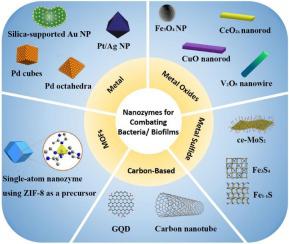Colloids and Surfaces B: Biointerfaces ( IF 5.4 ) Pub Date : 2020-11-12 , DOI: 10.1016/j.colsurfb.2020.111465 Yanyan Li 1 , Wenxin Zhu 1 , Jianshu Li 1 , Hetao Chu 1

|
Nanozyme belonging to artificial enzyme is a term describing nanomaterial with enzyme-like characteristics. Great research advances have been acquired in the field of nanozymes due to their striking merits. Inspired by natural enzymes that disrupt the structural integrity of cells or interfere with metabolism, nanozymes which can effectively avoid generation of bacterial resistance may become potential alternatives for antibiotics in the context of the continuous emergence and rapid spread of drug-resistant bacteria and the slow development of new antibiotics. Naturally, nanozymes inevitably have some inherent defects, which need to be compensated by forming composite materials with other components to play a synergistic effect. What’s more, nanozyme-based composite materials retain the advantages of nanozymes and integrate multiple functions into a single system to achieve an intelligent and multi-functional therapeutic model. This is a new strategy for combating bacteria/biofilms in the future. In this review, firstly we cover the general mechanisms and design principles of nanozyme-based composite materials for fighting against bacteria/biofilms and the typical types of nanozymes for resisting bacteria/biofilms. Meanwhile the applications and the advantages of nanozyme-based composite materials for anti-bacteria and anti-biofilms are emphasized. Finally, the challenges and prospects of nanozyme-based composite materials for combating bacteria/biofilms are discussed for future research in this field.
中文翻译:

纳米酶基复合材料抗细菌和生物膜的研究进展
属于人造酶的纳米酶是描述具有酶样特性的纳米材料的术语。由于其卓越的优点,在纳米酶领域已取得了巨大的研究进展。受到破坏细胞结构完整性或干扰新陈代谢的天然酶的启发,可以有效避免细菌耐药性的纳米酶可能会在耐药菌不断出现和迅速传播以及缓慢发展的背景下成为抗生素的潜在替代品。新的抗生素。自然地,纳米酶不可避免地具有一些固有的缺陷,需要通过与其他成分形成复合材料来发挥协同作用来弥补这些缺陷。更重要的是,基于纳米酶的复合材料保留了纳米酶的优势,并将多种功能集成到单个系统中,从而实现了智能的多功能治疗模型。这是将来对抗细菌/生物膜的新策略。在这篇综述中,首先我们介绍了基于纳米酶的复合材料对抗细菌/生物膜的一般机制和设计原理,以及抵抗细菌/生物膜的纳米酶的典型类型。同时强调了纳米酶基复合材料在抗菌和生物膜领域的应用和优势。最后,讨论了基于纳米酶的复合材料对抗细菌/生物膜的挑战和前景,以供该领域的未来研究。这是将来对抗细菌/生物膜的新策略。在这篇综述中,首先我们介绍了基于纳米酶的复合材料对抗细菌/生物膜的一般机制和设计原理,以及抵抗细菌/生物膜的纳米酶的典型类型。同时强调了纳米酶基复合材料在抗菌和生物膜领域的应用和优势。最后,讨论了基于纳米酶的复合材料对抗细菌/生物膜的挑战和前景,以供该领域的未来研究。这是将来对抗细菌/生物膜的新策略。在这篇综述中,首先我们介绍了基于纳米酶的复合材料对抗细菌/生物膜的一般机制和设计原理,以及抵抗细菌/生物膜的纳米酶的典型类型。同时强调了纳米酶基复合材料在抗菌和生物膜领域的应用和优势。最后,讨论了基于纳米酶的复合材料对抗细菌/生物膜的挑战和前景,以供该领域的未来研究。首先,我们介绍了基于纳米酶的复合材料对抗细菌/生物膜的一般机理和设计原理,以及抵抗细菌/生物膜的纳米酶的典型类型。同时强调了纳米酶基复合材料在抗菌和生物膜领域的应用和优势。最后,讨论了基于纳米酶的复合材料对抗细菌/生物膜的挑战和前景,以供该领域的未来研究。首先,我们介绍了基于纳米酶的复合材料对抗细菌/生物膜的一般机理和设计原理,以及抵抗细菌/生物膜的纳米酶的典型类型。同时强调了纳米酶基复合材料在抗菌和生物膜领域的应用和优势。最后,讨论了基于纳米酶的复合材料对抗细菌/生物膜的挑战和前景,以供该领域的未来研究。









































 京公网安备 11010802027423号
京公网安备 11010802027423号